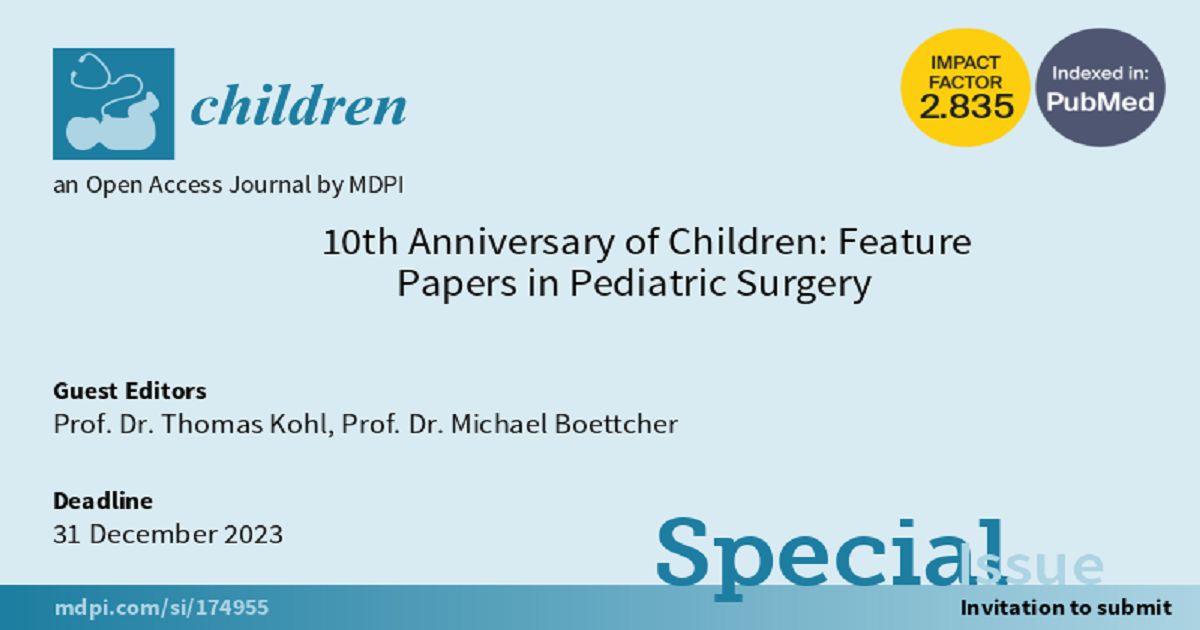10th Anniversary of Children: Feature Papers in Pediatric Surgery
A special issue of Children (ISSN 2227-9067). This special issue belongs to the section "Pediatric Surgery".
Deadline for manuscript submissions: closed (31 December 2023) | Viewed by 15406

Special Issue Editors
Interests: all aspects of minimally-invasive fetal surgery and therapy
Interests: paediatric surgery; minimally-invasive surgery; laparoscopic and thoracoscopic surgery
Special Issues, Collections and Topics in MDPI journals
Special Issue Information
Dear Colleagues,
We are celebrating the 10th anniversary of Children with a Special Issue in the Section “Pediatric Surgery” in 2023.
On behalf of the Editor-in-Chief, Prof. Dr. Paul R. Carney, members of the Editorial Office, and ourselves as Guest Editors, we would like to take this opportunity to thank our authors and reviewers for their valuable contributions in ensuring that Children is a successful and respected journal in its field. To celebrate the journal’s 10th anniversary, we will be serving as Guest Editors of a Special Issue that focuses on the clinical care, service delivery, and research related to the care of children within the context of pediatric surgery.
Fetal surgery has become a clinical reality in many tertiary care centers around the world. Over the past 30 years, a growing spectrum of different minimally invasive approaches have helped to save the life or improve the postnatal quality of life of thousands of patients. Spreading the word about the availability, techniques, and outcome of fetal interventions will help to save many more.
We warmly invite original research and state-of-the-art review/perspective contributions on all aspects of pediatric surgery and fetal surgery, including ethics, pain management, perioperative management, procedures, amniotic insufflation, benefits and risks, maternal and child outcomes, as well as experimental development.
Prof. Dr. Thomas Kohl
Prof. Dr. Michael Boettcher
Guest Editors
Manuscript Submission Information
Manuscripts should be submitted online at www.mdpi.com by registering and logging in to this website. Once you are registered, click here to go to the submission form. Manuscripts can be submitted until the deadline. All submissions that pass pre-check are peer-reviewed. Accepted papers will be published continuously in the journal (as soon as accepted) and will be listed together on the special issue website. Research articles, review articles as well as short communications are invited. For planned papers, a title and short abstract (about 100 words) can be sent to the Editorial Office for announcement on this website.
Submitted manuscripts should not have been published previously, nor be under consideration for publication elsewhere (except conference proceedings papers). All manuscripts are thoroughly refereed through a single-blind peer-review process. A guide for authors and other relevant information for submission of manuscripts is available on the Instructions for Authors page. Children is an international peer-reviewed open access monthly journal published by MDPI.
Please visit the Instructions for Authors page before submitting a manuscript. The Article Processing Charge (APC) for publication in this open access journal is 2400 CHF (Swiss Francs). Submitted papers should be well formatted and use good English. Authors may use MDPI's English editing service prior to publication or during author revisions.
Keywords
- fetal surgery
- fetoscopy
- pediatric surgery
- congenital malformations
- fetus
- surgical innovation
Benefits of Publishing in a Special Issue
- Ease of navigation: Grouping papers by topic helps scholars navigate broad scope journals more efficiently.
- Greater discoverability: Special Issues support the reach and impact of scientific research. Articles in Special Issues are more discoverable and cited more frequently.
- Expansion of research network: Special Issues facilitate connections among authors, fostering scientific collaborations.
- External promotion: Articles in Special Issues are often promoted through the journal's social media, increasing their visibility.
- Reprint: MDPI Books provides the opportunity to republish successful Special Issues in book format, both online and in print.
Further information on MDPI's Special Issue policies can be found here.







